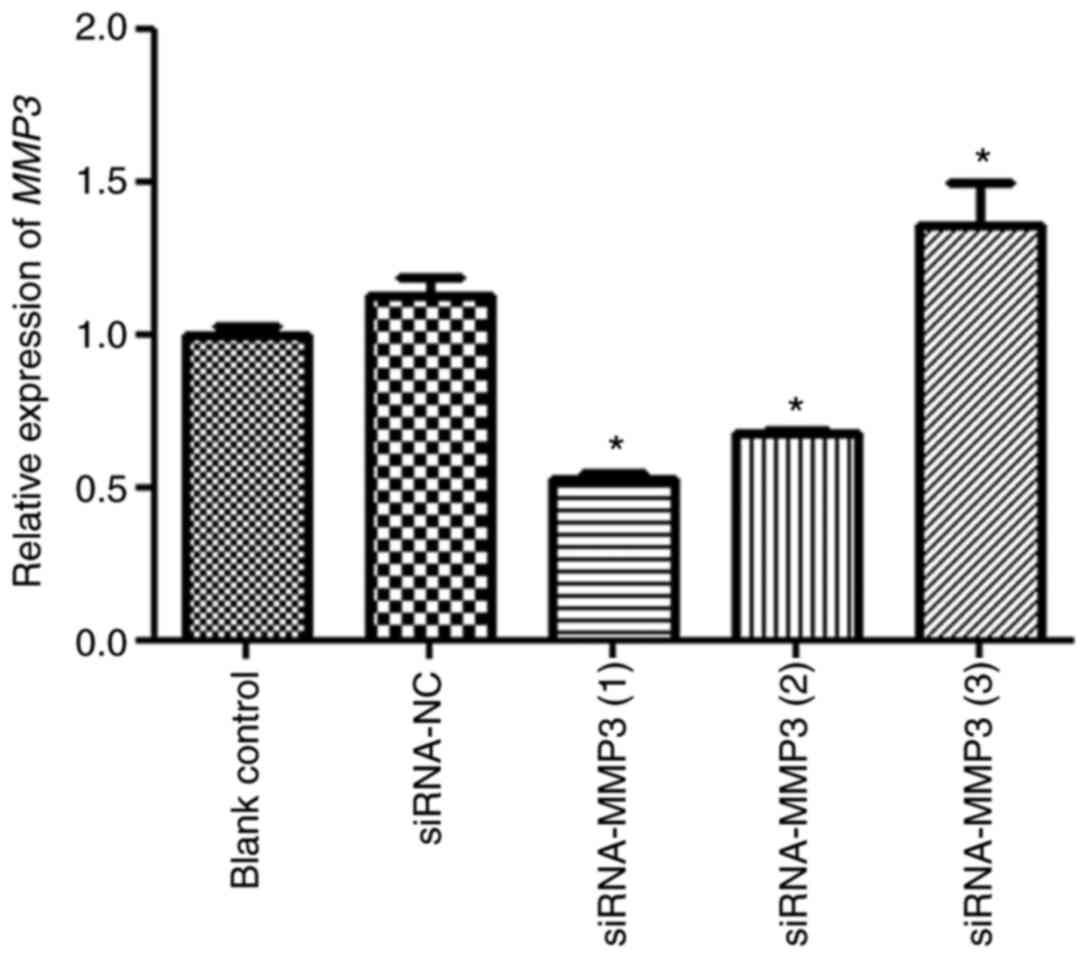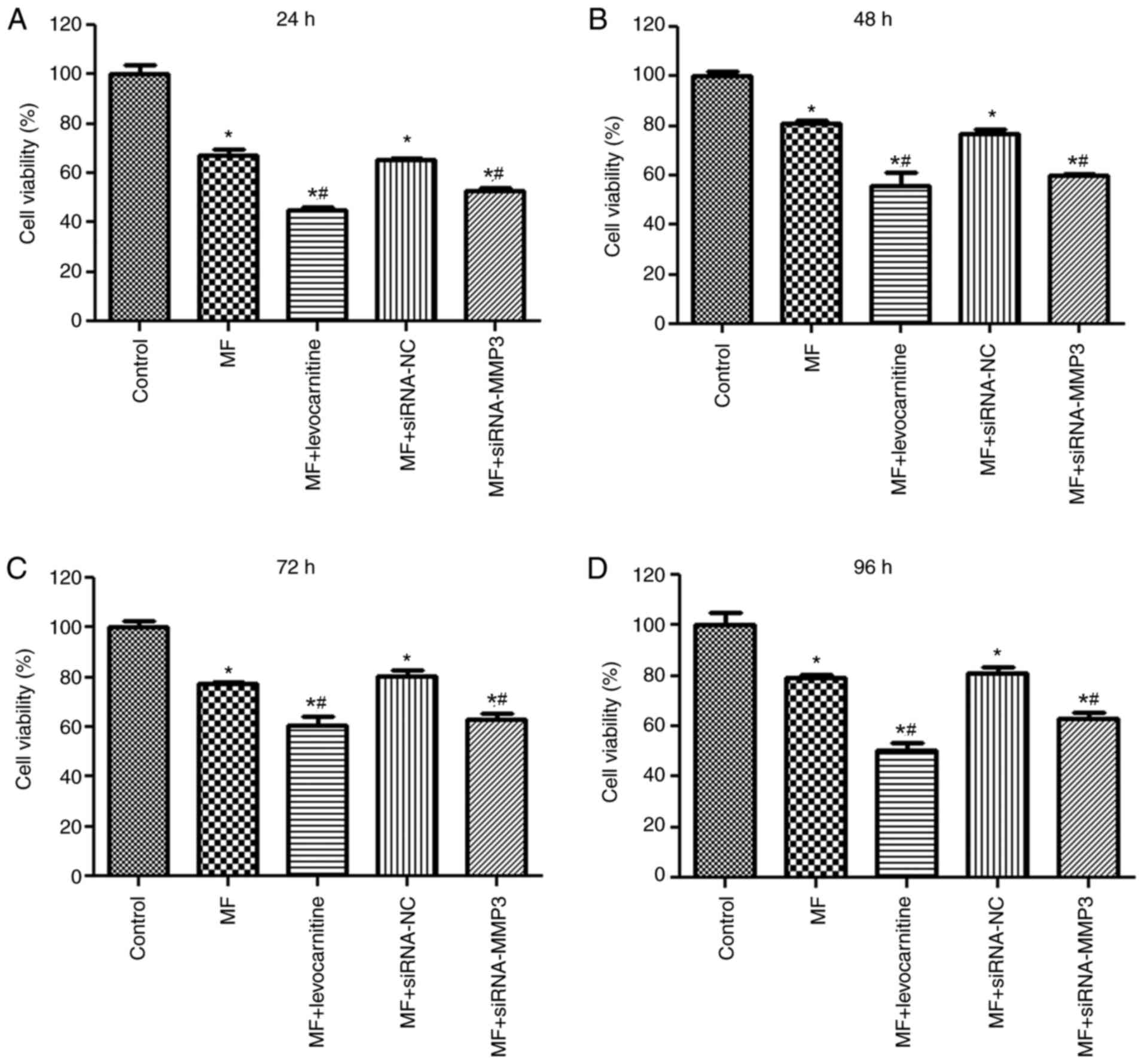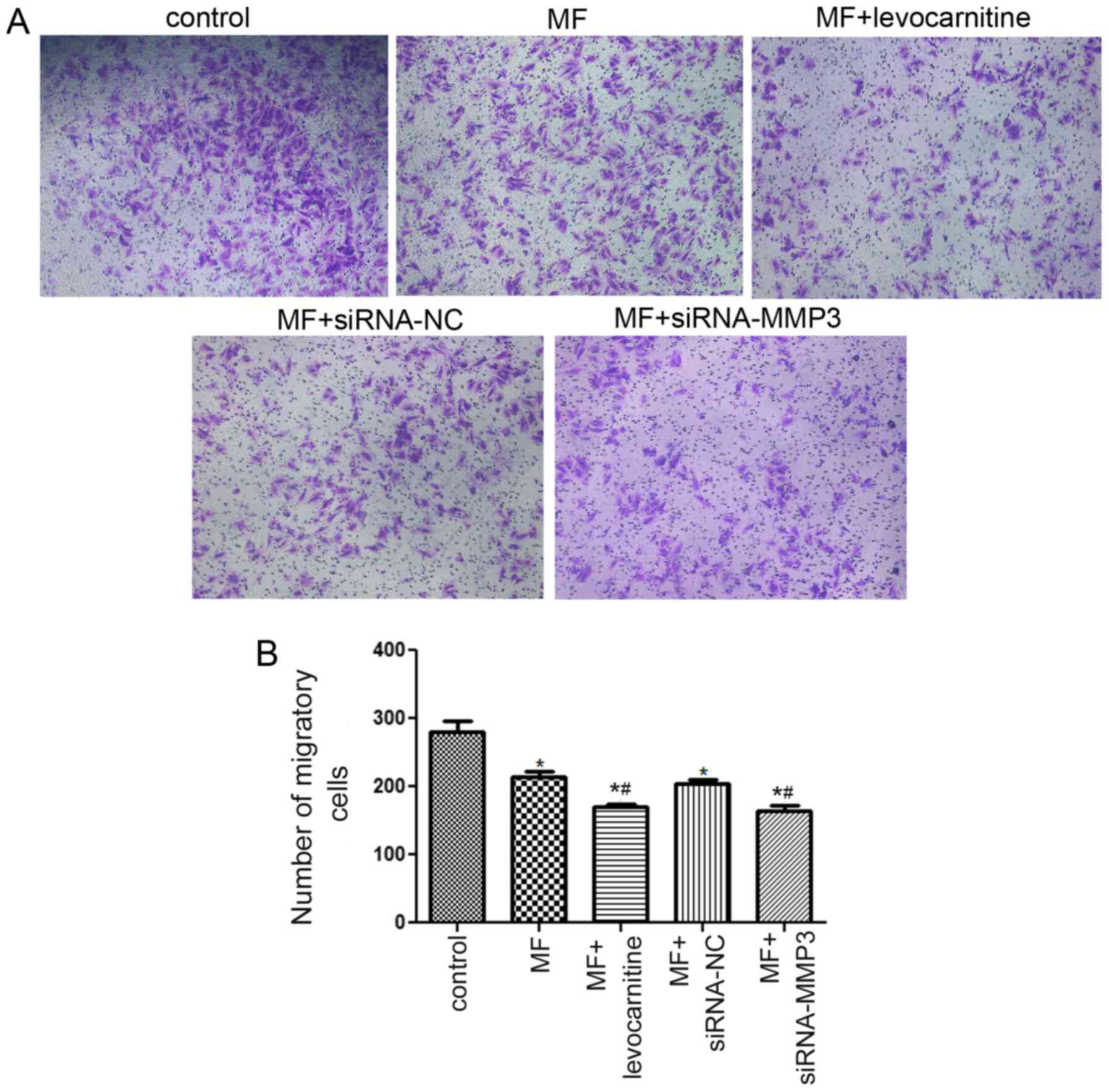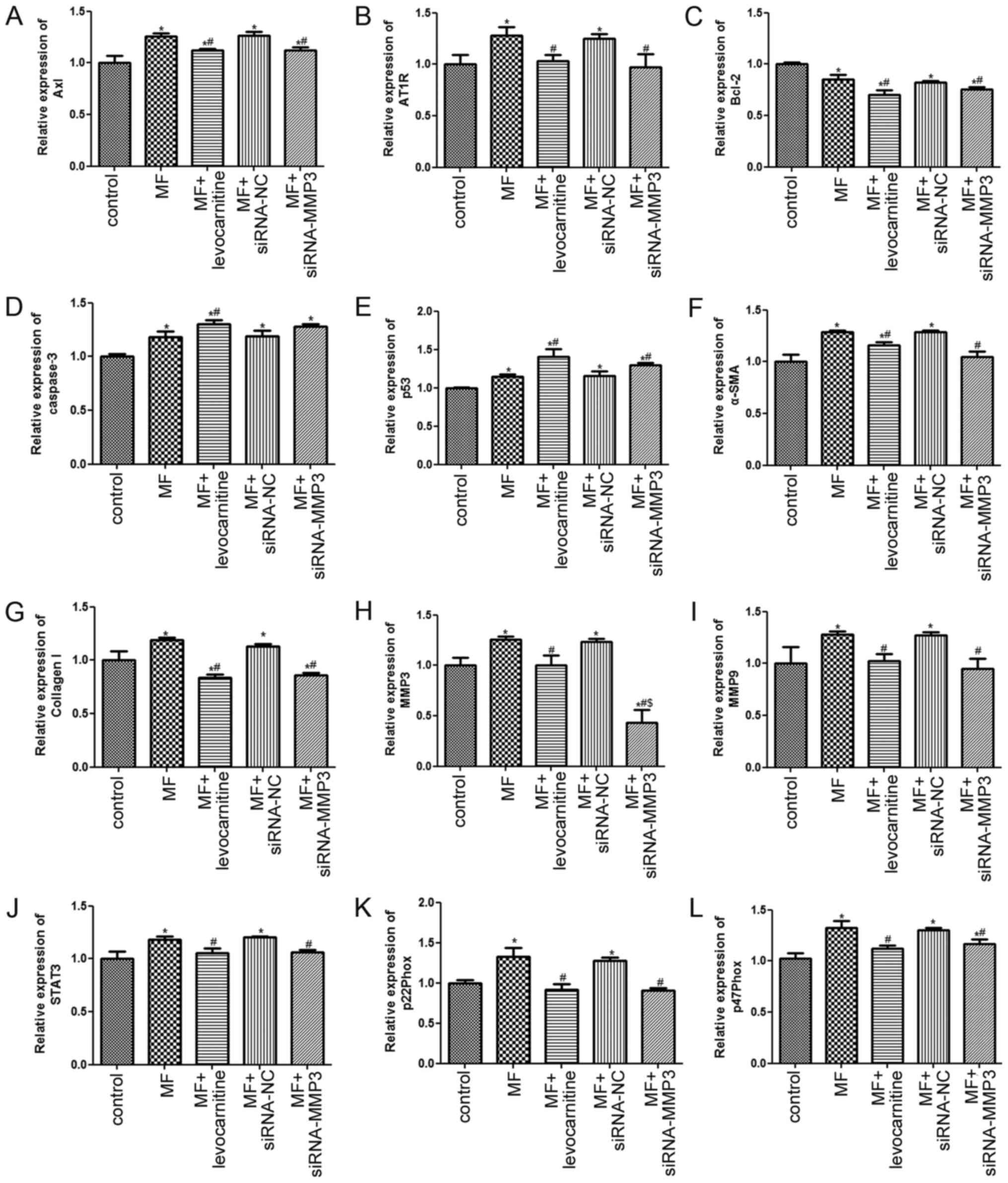|
1
|
Talman V and Ruskoaho H: Cardiac fibrosis
in myocardial infarction-from repair and remodeling to
regeneration. Cell Tissue Res. 365:563–581. 2016. View Article : Google Scholar : PubMed/NCBI
|
|
2
|
Hao G, Wang X, Chen Z, Zhang L, Zhang Y,
Wei B, Zheng C, Kang Y, Jiang L, Zhu Z, et al China Hypertension
Survey Investigators, : Prevalence of heart failure and left
ventricular dysfunction in China: The China Hypertension Survey,
2012–2015. Eur J Heart Fail. 21:1329–1337. 2019. View Article : Google Scholar : PubMed/NCBI
|
|
3
|
González A, Schelbert EB, Díez J and
Butler J: Myocardial interstitial fibrosis in heart failure:
Biological and translational perspectives. J Am Coll Cardiol.
71:1696–1706. 2018. View Article : Google Scholar : PubMed/NCBI
|
|
4
|
Kong P, Christia P and Frangogiannis NG:
The pathogenesis of cardiac fibrosis. Cell Mol Life Sci.
71:549–574. 2014. View Article : Google Scholar : PubMed/NCBI
|
|
5
|
Aoki T, Fukumoto Y, Sugimura K, Oikawa M,
Satoh K, Nakano M, Nakayama M and Shimokawa H: Prognostic impact of
myocardial interstitial fibrosis in non-ischemic heart failure.
-Comparison between preserved and reduced ejection fraction heart
failure. Circ J. 75:2605–2613. 2011. View Article : Google Scholar : PubMed/NCBI
|
|
6
|
Gyöngyösi M, Winkler J, Ramos I, Do QT,
Firat H, McDonald K, González A, Thum T, Díez J, Jaisser F, et al:
Myocardial fibrosis: Biomedical research from bench to bedside. Eur
J Heart Fail. 19:177–191. 2017. View
Article : Google Scholar : PubMed/NCBI
|
|
7
|
Helm PA, Caravan P, French BA, Jacques V,
Shen L, Xu Y, Beyers RJ, Roy RJ, Kramer CM and Epstein FH:
Postinfarction myocardial scarring in mice: Molecular MR imaging
with use of a collagen-targeting contrast agent. Radiology.
247:788–796. 2008. View Article : Google Scholar : PubMed/NCBI
|
|
8
|
López B, González A, Ravassa S, Beaumont
J, Moreno MU, San José G, Querejeta R and Díez J: Circulating
biomarkers of myocardial fibrosis: The need for a reappraisal. J Am
Coll Cardiol. 65:2449–2456. 2015. View Article : Google Scholar : PubMed/NCBI
|
|
9
|
Ellison DH and Felker GM: Diuretic
treatment in heart failure. N Engl J Med. 377:1964–1975. 2017.
View Article : Google Scholar : PubMed/NCBI
|
|
10
|
Schupp T, Behnes M, Weiss C, Nienaber C,
Reiser L, Bollow A, Taton G, Reichelt T, Ellguth D, Engelke N, et
al: Digitalis therapy and risk of recurrent ventricular
tachyarrhythmias and ICD therapies in atrial fibrillation and heart
failure. Cardiology. 142:129–140. 2019. View Article : Google Scholar : PubMed/NCBI
|
|
11
|
Schafer S, Viswanathan S, Widjaja AA, Lim
WW, Moreno-Moral A, DeLaughter DM, Ng B, Patone G, Chow K, Khin E,
et al: IL-11 is a crucial determinant of cardiovascular fibrosis.
Nature. 552:110–115. 2017. View Article : Google Scholar : PubMed/NCBI
|
|
12
|
Shinde AV, Humeres C and Frangogiannis NG:
The role of α-smooth muscle actin in fibroblast-mediated matrix
contraction and remodeling. Biochim Biophys Acta Mol Basis Dis.
1863:298–309. 2017. View Article : Google Scholar : PubMed/NCBI
|
|
13
|
Zhang Y, Luo G, Zhang Y, Zhang M, Zhou J,
Gao W, Xuan X, Yang X, Yang D, Tian Z, et al: Critical effects of
long non-coding RNA on fibrosis diseases. Exp Mol Med. 50:e4282018.
View Article : Google Scholar : PubMed/NCBI
|
|
14
|
Zhang X, Pan L, Yang K, Fu Y, Liu Y, Chi
J, Zhang X, Hong S, Ma X and Yin X: H3 relaxin protects against
myocardial injury in experimental diabetic cardiomyopathy by
inhibiting myocardial apoptosis, fibrosis and inflammation. Cell
Physiol Biochem. 43:1311–1324. 2017. View Article : Google Scholar : PubMed/NCBI
|
|
15
|
Kazakov A, Hall RA, Werner C, Meier T,
Trouvain A, Rodionycheva S, Nickel A, Lammert F, Maack C, Böhm M,
et al: Raf kinase inhibitor protein mediates myocardial fibrosis
under conditions of enhanced myocardial oxidative stress. Basic Res
Cardiol. 113:422018. View Article : Google Scholar : PubMed/NCBI
|
|
16
|
Batlle M, Recarte-Pelz P, Roig E, Castel
MA, Cardona M, Farrero M, Ortiz JT, Campos B, Pulgarín MJ, Ramírez
J, et al: AXL receptor tyrosine kinase is increased in patients
with heart failure. Int J Cardiol. 173:402–409. 2014. View Article : Google Scholar : PubMed/NCBI
|
|
17
|
Zheng RH, Bai XJ, Zhang WW, Wang J, Bai F,
Yan CP, James EA, Bose HS, Wang NP and Zhao ZQ: Liraglutide
attenuates cardiac remodeling and improves heart function after
abdominal aortic constriction through blocking angiotensin II type
1 receptor in rats. Drug Des Devel Ther. 13:2745–2757. 2019.
View Article : Google Scholar : PubMed/NCBI
|
|
18
|
Zachariah JP, Colan SD, Lang P, Triedman
JK, Alexander ME, Walsh EP, Berul CI and Cecchin F: Circulating
matrix metalloproteinases in adolescents with hypertrophic
cardiomyopathy and ventricular arrhythmia. Circ Heart Fail.
5:462–466. 2012. View Article : Google Scholar : PubMed/NCBI
|
|
19
|
Shu J, Liu Z, Jin L and Wang H: An RNA
sequencing study identifies candidate genes for angiotensin II
induced cardiac remodeling. Mol Med Rep. 17:1954–1962.
2018.PubMed/NCBI
|
|
20
|
Craig VJ, Zhang L, Hagood JS and Owen CA:
Matrix metalloproteinases as therapeutic targets for idiopathic
pulmonary fibrosis. Am J Respir Cell Mol Biol. 53:585–600. 2015.
View Article : Google Scholar : PubMed/NCBI
|
|
21
|
Kitanaka N, Nakano R, Sakai M, Kitanaka T,
Namba S, Konno T, Nakayama T and Sugiya H: ERK1/ATF-2 signaling
axis contributes to interleukin-1β-induced MMP-3 expression in
dermal fibroblasts. PLoS One. 14:e02228692019. View Article : Google Scholar : PubMed/NCBI
|
|
22
|
Tuncer T, Kaya A, Gulkesen A, Kal GA,
Kaman D and Akgol G: Matrix metalloproteinase-3 levels in relation
to disease activity and radiological progression in rheumatoid
arthritis. Adv Clin Exp Med. 28:665–670. 2019. View Article : Google Scholar : PubMed/NCBI
|
|
23
|
Patel VB, Zhong JC, Grant MB and Oudit GY:
Role of the ACE2/Angiotensin 1–7 axis of the renin-angiotensin
system in heart failure. Circ Res. 118:1313–1326. 2016. View Article : Google Scholar : PubMed/NCBI
|
|
24
|
Jin HY, Song B, Oudit GY, Davidge ST, Yu
HM, Jiang YY, Gao PJ, Zhu DL, Ning G, Kassiri Z, et al: ACE2
deficiency enhances angiotensin II-mediated aortic profilin-1
expression, inflammation and peroxynitrite production. PLoS One.
7:e385022012. View Article : Google Scholar : PubMed/NCBI
|
|
25
|
Sahoo S, Meijles DN, Al Ghouleh I, Tandon
M, Cifuentes-Pagano E, Sembrat J, Rojas M, Goncharova E and Pagano
PJ: MEF2C-MYOCD and leiomodin1 suppression by miRNA-214 promotes
smooth muscle cell phenotype switching in pulmonary arterial
hypertension. PLoS One. 11:e01537802016. View Article : Google Scholar : PubMed/NCBI
|
|
26
|
Xu G, Ao R, Zhi Z, Jia J and Yu B: miR-21
and miR-19b delivered by hMSC-derived EVs regulate the apoptosis
and differentiation of neurons in patients with spinal cord injury.
J Cell Physiol. 234:10205–10217. 2019. View Article : Google Scholar : PubMed/NCBI
|
|
27
|
Fagone P, Mangano K, Pesce A, Portale TR,
Puleo S and Nicoletti F: Emerging therapeutic targets for the
treatment of hepatic fibrosis. Drug Discov Today. 21:369–375. 2016.
View Article : Google Scholar : PubMed/NCBI
|
|
28
|
Gungor O, Unal HU, Guclu A, Gezer M,
Eyileten T, Guzel FB, Altunoren O, Erken E, Oguz Y, Kocyigit I, et
al: IL-33 and ST2 levels in chronic kidney disease: Associations
with inflammation, vascular abnormalities, cardiovascular events,
and survival. PLoS One. 12:e01789392017. View Article : Google Scholar : PubMed/NCBI
|
|
29
|
Ke B, Zhu N, Luo F, Xu Y and Fang X:
Targeted inhibition of endoplasmic reticulum stress: New hope for
renal fibrosis (Review). Mol Med Rep. 16:1014–1020. 2017.
View Article : Google Scholar : PubMed/NCBI
|
|
30
|
Fagone P, Mangano K, Mammana S, Pesce A,
Pesce A, Caltabiano R, Giorlandino A, Portale TR, Cavalli E,
Lombardo GA, et al: Identification of novel targets for the
diagnosis and treatment of liver fibrosis. Int J Mol Med.
36:747–752. 2015. View Article : Google Scholar : PubMed/NCBI
|
|
31
|
Ambale-Venkatesh B, Liu CY, Liu YC,
Donekal S, Ohyama Y, Sharma RK, Wu CO, Post WS, Hundley GW, Bluemke
DA, et al: Association of myocardial fibrosis and cardiovascular
events: The multi-ethnic study of atherosclerosis. Eur Heart J
Cardiovasc Imaging. 20:168–176. 2019. View Article : Google Scholar : PubMed/NCBI
|
|
32
|
Chin CWL, Everett RJ, Kwiecinski J, Vesey
AT, Yeung E, Esson G, Jenkins W, Koo M, Mirsadraee S, White AC, et
al: Myocardial fibrosis and cardiac decompensation in aortic
stenosis. JACC Cardiovasc Imaging. 10:1320–1333. 2017. View Article : Google Scholar : PubMed/NCBI
|
|
33
|
Gulati A, Japp AG, Raza S, Halliday BP,
Jones DA, Newsome S, Ismail NA, Morarji K, Khwaja J, Spath N, et
al: Absence of myocardial fibrosis predicts favorable long-term
survival in new-onset heart failure. Circ Cardiovasc Imaging.
11:e0077222018. View Article : Google Scholar : PubMed/NCBI
|
|
34
|
Mirastschijski U, Lupše B, Maedler K,
Sarma B, Radtke A, Belge G, Dorsch M, Wedekind D, McCawley LJ,
Boehm G, et al: Matrix metalloproteinase-3 is key effector of
TNF-α-induced collagen degradation in skin. Int J Mol Sci.
20:202019. View Article : Google Scholar
|
|
35
|
Wang Q, Sui X, Chen R, Ma PY, Teng YL,
Ding T, Sui DJ and Yang P: Ghrelin ameliorates angiotensin
ii-induced myocardial fibrosis by upregulating peroxisome
proliferator-activated receptor gamma in young male rats. BioMed
Res Int. 2018:98975812018.PubMed/NCBI
|
|
36
|
Wu P, Liu Z, Zhao T, Xia F, Gong L, Zheng
Z, Chen Z, Yang T and Duan Q: Lovastatin attenuates angiotensin II
induced cardiovascular fibrosis through the suppression of YAP/TAZ
signaling. Biochem Biophys Res Commun. 512:736–741. 2019.
View Article : Google Scholar : PubMed/NCBI
|
|
37
|
Berg G, Barchuk M and Miksztowicz V:
Behavior of metalloproteinases in adipose tissue, liver and
arterial wall: An update of extracellular matrix remodeling. Cells.
8:82019. View Article : Google Scholar
|
|
38
|
Taha EA, Sogawa C, Okusha Y, Kawai H, Oo
MW, Elseoudi A, Lu Y, Nagatsuka H, Kubota S, Satoh A, et al:
Knockout of MMP3 weakens solid tumor organoids and cancer
extracellular vesicles. Cancers (Basel). 12:122020. View Article : Google Scholar
|
|
39
|
Bufu T, Di X, Yilin Z, Gege L, Xi C and
Ling W: Celastrol inhibits colorectal cancer cell proliferation and
migration through suppression of MMP3 and MMP7 by the PI3K/AKT
signaling pathway. Anticancer Drugs. 29:530–538. 2018. View Article : Google Scholar : PubMed/NCBI
|
|
40
|
McShane L, Tabas I, Lemke G,
Kurowska-Stolarska M and Maffia P: TAM receptors in cardiovascular
disease. Cardiovasc Res. 115:1286–1295. 2019. View Article : Google Scholar : PubMed/NCBI
|
|
41
|
Zhang LH, Pang XF, Bai F, Wang NP, Shah
AI, McKallip RJ, Li XW, Wang X and Zhao ZQ: Preservation of
glucagon-like peptide-1 level attenuates angiotensin ii-induced
tissue fibrosis by altering AT1/AT2 receptor expression and
angiotensin-converting enzyme 2 activity in rat heart. Cardiovasc
Drugs Ther. 29:243–255. 2015. View Article : Google Scholar : PubMed/NCBI
|
|
42
|
Zhang WW, Bai F, Wang J, Zheng RH, Yang
LW, James EA and Zhao ZQ: Edaravone inhibits pressure
overload-induced cardiac fibrosis and dysfunction by reducing
expression of angiotensin II AT1 receptor. Drug Des Devel Ther.
11:3019–3033. 2017. View Article : Google Scholar : PubMed/NCBI
|
|
43
|
Harikrishnan V, Titus AS, Cowling RT and
Kailasam S: Collagen receptor cross-talk determines α-smooth muscle
actin-dependent collagen gene expression in angiotensin
II-stimulated cardiac fibroblasts. J Biol Chem. 294:19723–19739.
2019. View Article : Google Scholar : PubMed/NCBI
|
|
44
|
Li N, Feng F, Wu K, Zhang H, Zhang W and
Wang W: Inhibitory effects of astragaloside IV on silica-induced
pulmonary fibrosis via inactivating TGF-beta1/Smad3 signaling.
Biomed Pharmacother. 119:1093872019. View Article : Google Scholar : PubMed/NCBI
|
|
45
|
Weder B, Mamie C, Rogler G, Clarke S,
McRae B, Ruiz PA and Hausmann M: BCL2 regulates differentiation of
intestinal fibroblasts. Inflamm Bowel Dis. 24:1953–1966. 2018.
View Article : Google Scholar : PubMed/NCBI
|
|
46
|
Lossi L, Castagna C and Merighi A:
Caspase-3 mediated cell death in the normal development of the
mammalian cerebellum. Int J Mol Sci. 19:192018. View Article : Google Scholar
|
|
47
|
Wang X, Simpson ER and Brown KA: p53:
Protection against tumor growth beyond effects on cell cycle and
apoptosis. Cancer Res. 75:5001–5007. 2015. View Article : Google Scholar : PubMed/NCBI
|
|
48
|
Wang JH, Zhao L, Pan X, Chen NN, Chen J,
Gong QL, Su F, Yan J, Zhang Y and Zhang SH: Hypoxia-stimulated
cardiac fibroblast production of IL-6 promotes myocardial fibrosis
via the TGF-β1 signaling pathway. Lab Invest. 96:839–852. 2016.
View Article : Google Scholar : PubMed/NCBI
|
|
49
|
Yao C, Cao X, Fu Z, Tian J, Dong W, Xu J,
An K, Zhai L and Yu J: Boschniakia rossica polysaccharide
triggers laryngeal carcinoma cell apoptosis by regulating
expression of Bcl-2, Caspase-3, and P53. Med Sci Monit.
23:2059–2064. 2017. View Article : Google Scholar : PubMed/NCBI
|
|
50
|
Tsutsui H, Kinugawa S and Matsushima S:
Oxidative stress and heart failure. Am J Physiol Heart Circ
Physiol. 301:H2181–H2190. 2011. View Article : Google Scholar : PubMed/NCBI
|
|
51
|
Singh S and Torzewski M: Fibroblasts and
their pathological functions in the fibrosis of aortic valve
sclerosis and atherosclerosis. Biomolecules. 9:92019. View Article : Google Scholar
|
|
52
|
Wang M, Kim SH, Monticone RE and Lakatta
EG: Matrix metalloproteinases promote arterial remodeling in aging,
hypertension, and atherosclerosis. Hypertension. 65:698–703. 2015.
View Article : Google Scholar : PubMed/NCBI
|
|
53
|
Zhang M, Xue Y, Chen H, Meng L, Chen B,
Gong H, Zhao Y and Qi R: Resveratrol inhibits MMP3 and MMP9
expression and secretion by suppressing TLR4/NF-κB/STAT3 activation
in Ox-LDL-treated HUVECs. Oxid Med Cell Longev.
2019:90131692019.PubMed/NCBI
|
|
54
|
Szczepanek K, Chen Q, Larner AC and
Lesnefsky EJ: Cytoprotection by the modulation of mitochondrial
electron transport chain: The emerging role of mitochondrial STAT3.
Mitochondrion. 12:180–189. 2012. View Article : Google Scholar : PubMed/NCBI
|
|
55
|
Han J, Ye S, Zou C, Chen T, Wang J, Li J,
Jiang L, Xu J, Huang W, Wang Y, et al: Angiotensin II causes
biphasic STAT3 activation through TLR4 to initiate cardiac
remodeling. Hypertension. 72:1301–1311. 2018. View Article : Google Scholar : PubMed/NCBI
|
|
56
|
Yim J, Cho H and Rabkin SW: Gene
expression and gene associations during the development of heart
failure with preserved ejection fraction in the Dahl salt sensitive
model of hypertension. Clin Exp Hypertens. 40:155–166. 2018.
View Article : Google Scholar : PubMed/NCBI
|





















